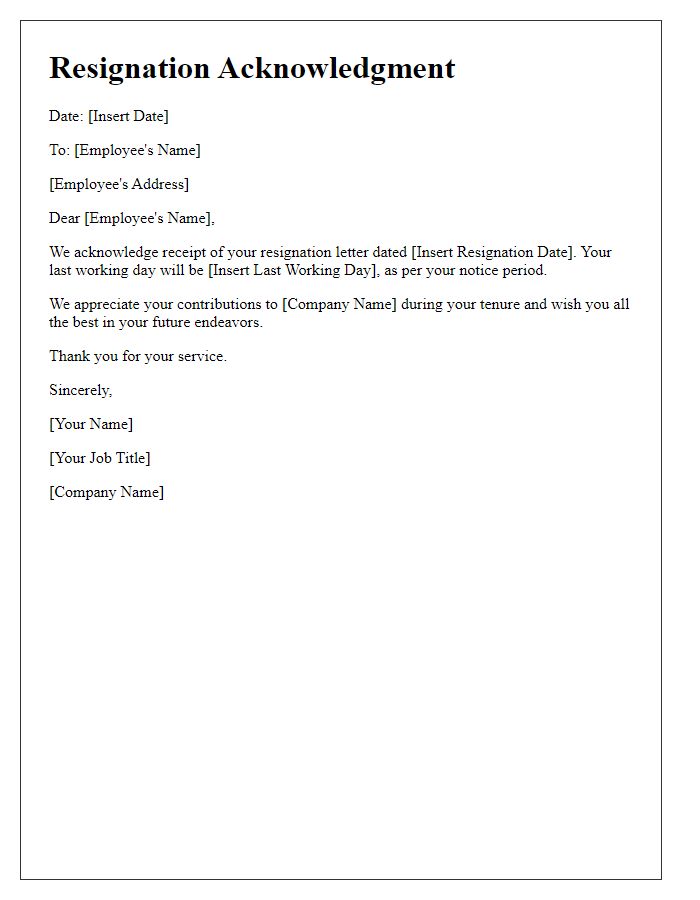When someone decides to part ways with an organization, it's important to respond to their resignation letter with grace and professionalism. A well-crafted acknowledgment not only reflects the company's culture but also reinforces positive relationships for the future. In your response, consider expressing gratitude for their contributions while wishing them success in their next endeavors. Curious about how to structure the perfect resignation acknowledgment letter? Read on for a detailed guide!

Acknowledgment of resignation receipt
Acknowledging the receipt of a resignation letter is crucial in maintaining professional relationships. A resignation letter, formally submitted by an employee, often signifies the conclusion of their tenure within a company. Upon receipt, it is essential to document the acknowledgment, typically referencing the date of the resignation, the employee's position, and the last working day. This process ensures transparency and facilitates smoother transitions, allowing for the appropriate time to organize handover activities, recruitment efforts, or internal adjustments to workflow. Additionally, a cordial acknowledgment reinforces respect for the individual's decision while preserving the integrity of the workplace atmosphere.
Last working day confirmation
An employee resignation often marks a significant transition within an organization. Acknowledging such a letter requires clarity and a professional tone. The resignation letter should state the last working day, typically two weeks (10 business days) from the submission date, unless otherwise specified. Important to note, this period may vary based on organizational policies or individual contracts. The acknowledgment should include appreciation for the employee's contributions during their tenure and details regarding exit procedures, such as final payments or knowledge transfer sessions. Providing contact information for the HR department ensures smooth communication regarding any outstanding matters, such as benefits or references. Such communications foster positive relationships and a professional atmosphere, even as employees transition away from the company.
Transition and handover instructions
Acknowledging a resignation letter involves recognizing the employee's departure and discussing the transition and handover instructions for ongoing projects. Ensure clarity regarding important tasks, deadlines, and responsibilities that need to be communicated to team members. Document an overview of ongoing projects, include timelines for project completion, and clarify where files and resources can be found. Arrange meetings with team members for knowledge transfer and outline critical tasks that require immediate attention post-departure. Highlight contact information for follow-up questions as a courtesy for ongoing collaborations. Consider mentioning any final administrative steps that the departing employee needs to complete, ensuring a smooth transition for both parties.
Appreciation for contributions
Acknowledging a resignation letter presents an opportunity to express gratitude for an employee's contributions. Consider highlighting key achievements such as leading successful projects or enhancing team dynamics. For instance, if an employee significantly improved sales by 30% at a company like Tech Innovations Inc. during 2022, this should be noted. Mention the individual's unique skills, like strategic thinking or mentorship, which benefited colleagues and the organization. The acknowledgment should also extend best wishes for their future endeavors, whether they are pursuing further education or new career opportunities. Celebrate the moments shared, underscoring an empathetic farewell while maintaining a professional tone.
Future contact details and best wishes
A resignation letter acknowledges the formal notice from an employee regarding their departure from a company or organization. It typically includes an expression of gratitude for the employee's contributions, a willingness to stay in touch, and an invitation to share future contact details. This gesture fosters goodwill and maintains a positive relationship between the employer and the departing employee. Well-wishes for future endeavors reflect the organization's respect for the employee's career choices, enhancing professional networks. Acknowledging such communications is essential for maintaining morale and a strong workplace culture, even amidst transitions.













Comments